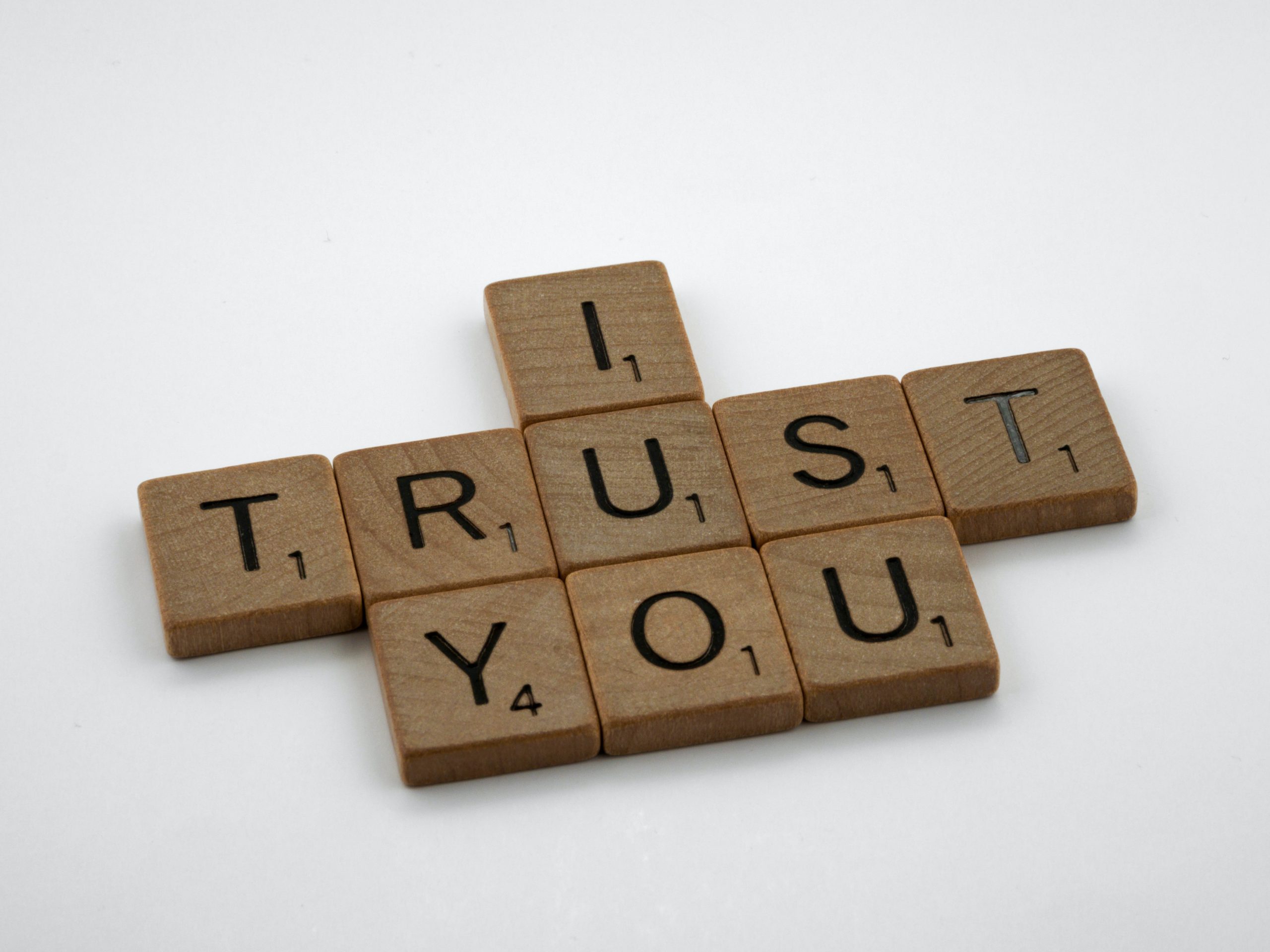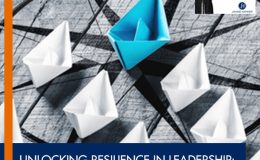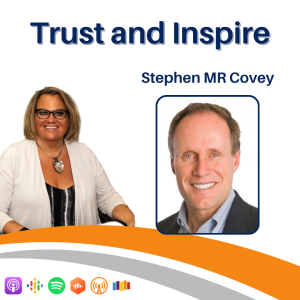
The old leadership principle of command and control has been in place for decades. What if there is a new way to lead? In this episode, Janine Hamner Holman sits down with Stephen M.R. Covey, a leader who inspires other leaders, to discuss the benefits of trust and inspiration in leadership and growth.
GUEST: Stephen M.R. Covey | LinkedIn, Instagram, Wikipedia
HOST: Janine Hamner Holman | [email protected] | LinkedIn, Facebook, Instagram
What am I paying attention to? I had a fascinating conversation with a professor at the Harvard Business School. We got to talking about the changes that have happened in the world of work and the pressure millennials and Gen Zs are putting on the workforce to have a different kind of work.
It was especially fascinating because this was an older gentleman, probably I would guess sixties or early seventies. He’s a professor. He certainly has been seeing some of these changes. His perspective is that there are a few things that have changed in the world of work. The only thing different about these younger generations is they don’t yet have mortgages, kids, and those types of things. That is completely not my perspective on things.
He also talked about how the only thing that has happened differently in the world of work is we have moved from an industrial mechanic age into a service industry age. That is calling for a different level of attention to the people in an organization, but really maybe not so much. That, again, is not my perspective.
It was both challenging and fun to have this conversation with this gentleman who has such a different idea about things than me, which brings me right to our guest for today, with whom I expect to have a bit more synergy. I am so excited about our guest.
Our guest is the amazing Stephen M.R. Covey. Stephen Covey is the author of Speed of Trust and his newer book, Trust and Inspire. He was the CEO of the Covey Leadership Institute that his father, who many of you may also be familiar with, Dr. Covey, created. Under Stephen’s leadership, the company grew to be the largest leadership development company in the world, operating in about 150 countries worldwide.
I am so honored to have Stephen M.R. Covey with us today. Welcome to the show, Stephen.
Wow. Well, thank you, Janine. I’m equally honored to be with you and have this chance to have this conversation. I’ve been looking forward to it and I’m excited we’re here together.
Wonderful, thank you so much. Tell me, Stephen, what is something you have become aware of we’re not paying enough attention to, and what’s it costing us?
Let me say the whole basis of this new book, Trust and Inspire, what we haven’t paid attention to is, I’m going to call it our leadership style. I’ll go further and say our leadership paradigm of how we view people, how we view leadership, is too much trapped in the old model, the old way of thinking, the traditional approach to leadership.
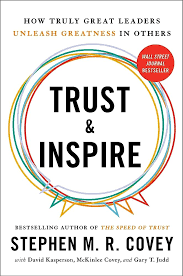
I give a name to it in the book, I call it command and control. What’s happened is we’ve become better at doing command and control, we’ve gotten more advanced. It’s the new and improved version. It’s a more advanced version of it, I call it enlightened command and control, which is the better version of it. But the paradigm, how we view people, how we view leadership, is still more the traditional model.
It’s juiced up with kindness and some good things about it, some mission and trustworthiness, but still too much above people. It’s a thing paradigm, an efficiency paradigm. We need to pay attention to how we’re leading and to the style of leadership we’re employing and that of our organization. There is a high cost to leading with the old command and control model. The cost is that we’re less and less relevant by the day with the people we’re leading.
I tend to agree with you, Janine, I’m more probably aligned with you than with this Harvard professor you mentioned. That is saying there are not many changes. I think there’s been a lot of change in a whole host of arenas, including technology for one, where there’s disruption now everywhere. But also, not only has the nature of work changed from the industrialization age to the knowledge-worker age, and the service model is far more collaborative, it’s far more interdependent.
These younger generations, in particular, Gen Z, but also millennials, have a completely different expectation of how they want to be engaged. Additionally, the workplace has changed quite a bit with work from home, remote work, hybrid work, and flexible work options that weren’t prevalent a few years ago.
There are so many options today in a way people didn’t have before where we can live here, work there, and suddenly have all these options. All these forces of change have put a premium on making sure we have a style of leadership that is relevant for our time.
For this new world of work, I like to say a new world of work requires a new way to lead. The old way, command and control, even the best version of it, the enlightened command and control is not relevant. We won’t attract the top talent. We won’t collaborate and innovate to stay relevant in this changing world with command and control. We need a new way to lead. I call it trust and inspire, in contrast to command and control. That’s the idea.
If you haven’t yet gotten Stephen’s book, Trust and Inspire, please do. It is brilliant and filled with wonderful anecdotes and amazing facts. One of the things that… I could write a book on all the things that stood out for me from your book, and one of them was when you were talking about the speed of information. Let’s see if I can get this right. In 1900, it took a century to double human knowledge, and back in 1982, it took, oh crap, what, like a year?
13 months.
I was close, 13 months to double human knowledge. Now it is taking…
12 hours.
12 hours to double human knowledge. When we think about the speed of disruption, the speed of information, the speed of change, and the speed of work, we are in a dramatically different paradigm than we’ve ever been in before.

Totally. Completely different. A level of change and disruption that’s unprecedented and it’s only going to continue. The pace of change, the amount of change, and the type of change are unprecedented.
Now we’re seeing what’s going to happen… we’re just in the front end of artificial intelligence and all the implications that will flow out of it, that we’ve yet to factor in and experience. All of this is hitting us in new and different ways, and that’s all part of the forces of change that change the nature of work today and require a different way of leading.
I want to get into both trust and inspire, and I’ve been working with a fairly large organization on trust. One of the things I realized when I started getting into this work with them is that people tend to have a perspective on trust that is, either trust is granted or trust is earned.
In my experience, when you’re working with folks who are in that first arena, the trust is granted arena, it is easier for them to get their minds around some things about trust and the way trust works. I’m curious about your perspective when you’re working and speaking with people, because I know you do a lot of keynote speaking these days.
When you are doing that with people who you have a hunch or you have data to say they’re in the trust is earned category, how does that change the way you talk with them about the trust part of trust and inspire?
Here’s the thing, they’re partly right, they’re half right.
I like to make the point that trust is earned. We have to demonstrate our character and our competence, our credibility. But also, trust is granted and that’s vital too. If someone is trustworthy, they could be working with another trustworthy person such that you have two trustworthy people working together and yet there might be no trust between them if neither person is willing to extend trust to the other.
I try to meet people where they’re at and say, we need to be trustworthy. We as leaders are people as a team, but it’s not enough to merely be trustworthy. You could have trustworthy people working together and no trust between them.
In addition to being trustworthy, which we earn, we as leaders need to be trusting, which we give, which we grant. find as I look at that simple formula of trustworthiness x trusting = trust, a high-trust team, high-trust culture, that the greater gap in the creation of trust is less that people aren’t trustworthy. Sometimes that’s the case, but it’s less that they haven’t earned it, it’s more on the side that we’re not trusting enough, we’re not giving enough trust.
One of the best ways to help bring about increased trustworthiness is to trust people, to give them the opportunity to extend trust and what it does to them, how they rise to the occasion, and how they want to live worthy of trust and live up to it.
The vast majority of people respond to being trusted. It brings out the best in them and they grow and develop new capabilities so you can trust them even more going forward and they tend to perform better. But here’s the great thing, they also tend to reciprocate and give the trust back to you. We need that as leaders.
We certainly do. If you’re a person for whom granting trust feels challenging, do you have any ideas? Is it just, “I know it’s uncomfortable and I will stretch into it” or in the work you have done studying trust now for a long time, do you have any specific ideas about… If that’s foreign to me, what are the baby steps I can take toward making that more of a routine for me?
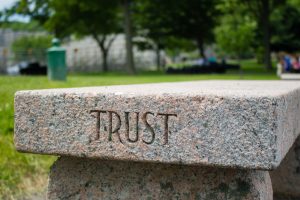
Beautiful. It’s a great question, Janine, because for some it’s really hard to extend that trust. It’s not that they don’t want to. I find in most cases, people want to trust, but they’re worried they might get burned or the person might not respond to the trust or they might be taken advantage of, or maybe the job doesn’t get done and they’re responsible for the results.
They usually have a desire, but they’re worried about it, maybe they’ve been burned before and it’s hard to trust when you’ve been burned badly. Here’s a couple of thoughts. The first is what I call smart trust.
It’s not a blind trust. A blind trust is indiscriminate, which is to trust anyone and everyone. I’m not saying that, and I’m not saying you just give trust freely, indiscriminately. No, use good judgment, and assess the situation.
You’re trying to assess the risk involved. If something is going to sink the company if it’s not done right then you need to be a lot more careful about giving trust in such an area.
What’s the risk involved and what’s the credibility of the person or people involved? If they have a strong track record of delivering and getting results, I can be far more trusting sooner and faster. If they’re brand new to the role, there’s a lot of risk, I’m going to be a lot more careful and cautious about how I extend trust. It’s not a one-size-fits-all all. It’s good judgment. I call it smart trust. That’s the first thing. Have that mindset.
I’ll give you the second key thing. When you extend trust, always build an agreement together around the trust being extended. That agreement has two parts, a clarity of expectations around the trust being given, including the desired results, and the guidelines to achieve those results and the resources we have.
Always clarify expectations around the trust being given, and mutually agree to a process of accountability against those expectations. That way you’re building an agreement. In that agreement, there’s some control of expectations and accountability. If I have built that agreement with the other person, then when I’m extending trust to them, it’s not, again, just a blind trust that’s indiscriminate without accountability.
It’s a smart trust with clear expectations and an agreed-upon process for accountability to those expectations. Suddenly the person feels empowered, but I’ve not lost control. I’ve shifted my control from having to hover over and micromanage their every move to having an agreement in place. This person is going to report back frequently on this agreement, and if the trust is kind of being earned, I have them report back more frequently.
If the trust has been established and is strong, maybe they report back routinely. I can tailor it to the situation and the person, to the trust being extended. But this way, by building that agreement together, it keeps smart trust smart and builds in control.
I love what you just said. By building that agreement together, because often as leaders, as managers, as bosses, many of us grew up in the world of work where I would say to you, “Stephen, I need you to be accountable for this thing.” I would hand it off and then I would go away. I would abandon you, and then you either got it done the way I wanted or you didn’t. I didn’t tell you much about how I wanted it done.
I love this combination of trust and accountability you are creating here because when I work with organizations on accountability, I say our normal paradigm of accountability is what I just described. We have an opportunity instead to create accountability as partners.
I can say to you, “Stephen, I need you to be accountable for this thing. Here’s what success is going to look like. Here’s why I need it the way I need it. Here’s what’s going to get created by you doing that, is that something for which you can be accountable?” Then you get to say yes or no. If you can’t say no, you can’t really say yes.
It’s a real conversation around, can you be accountable for this thing? If the answer’s no, then we figure it out, and can you be accountable for a piece of it or do we have to rejigger your workload? If I need you to be accountable for this thing, then I get to ask what you need from me in order for you to be accountable.
This made me think about the charming story you tell about clean and green. I love that story because we can all connect to it. Because it connects so well with what you’re talking about, would you tell us that story, please?

Absolutely. It’s one of my favorites. This happened with my dad when he was trying to teach us kids responsibility. He gave me the responsibility in a family meeting to take care of the lawn. I volunteered for it. I was a young boy, seven years old, and he trained me over a couple week period how to take care of the lawn, to make sure it was green and it was clean. Now this was back in the days before automatic sprinklers, back when you had to manually do everything.
We had three pieces of lawn in three different parts of the house I had to watch over. He trained me over a two-week period and taught me what green looked like and what clean looked like. We would clean part of the yard and leave the other part unclean. I would see the difference. Again, I’m seven years old, he trained me, built an agreement with me, and turned it over to me after two weeks.
I’m a little bit ashamed to say, I did nothing.
I was seven. It was the middle of the summer, so it was scorching hot. First day goes by, and I do nothing. Second day, nothing. Third day, nothing. Fourth day, nothing. Fifth day, nothing. The lawn is turning yellow by the hour at this point. Rather than green and clean, it’s yellow and messy because we had a family barbecue over the weekend where people threw cups and plates and everything. My dad was so tempted to say, “You know what? I tried, but he’s too young.”
He was tempted to go back to command and control, but he didn’t. He stayed with it. He realized that his greater purpose was to raise the child, not the lawn.
He stayed with it, he went back to the agreement we built together and he said, “Why don’t we walk around the yard like we agreed and you can tell me how it’s going?” That was part of the agreement. I would judge myself against the standard of green and clean. That was all in line with the agreement.
He wasn’t violating the agreement, he was living up to it. We walked around the yard and I began to break down and cry. I realized this was not green and clean. I said it was so hard. He said, you haven’t done one thing yet. What was hard was learning to take responsibility, to take initiative, to own it, and to be accountable.
My dad had agreed he would help me if he had time. I said, “Dad, you have time. Would you help me?” He says, “I’ve got time.” I ran into the house and got two garbage sacks. I took one and I gave one to my dad.
Then I began to instruct him and said, “Dad, would you go over there and pick up that garbage because it makes me want to vomit?” He says, “I’m your helper. I’ll do whatever you want.” At that moment I realized “This is my job. I own this. Look, my dad is responding to what I’m telling him to do. He’s my helper. I’m in charge.” I realized at that time I own this job and I began to take responsibility. From that day forward, I began to see myself differently, as responsible.
I took care of that lawn and it was green and it was clean not only for that summer but for many, many summers to come. I rose to the occasion. Here’s what happened, my father, he was doing trust and inspire with me. He built the agreement together. He extended trust to me with expectations and accountability, but I felt trusted by my dad and that inspired me. I wanted to be worthy of it. I wanted to live up to it.
What he did above all was, he treated me according to my potential, not my behavior. I ultimately rose to my potential versus down to my behavior where I might get into a vicious cycle. He treated me according to my potential and I began to live up to it and I began to see myself differently.
It’s a great example at the most basic level with a seven-year-old of how people respond to being trusted. With that trust, if you build the agreement together, you can have expectations and accountability. I love how you said it earlier, Janine. You said, when you do accountability work, we’re partners, we’re doing this with each other and not to each other.
You could build the agreement in a command and control way where you just dictate the agreement. It’s all one-sided, saying, here’s what it is, here’s the results, here’s the guidelines. You’re accountable to me, I’ll come and see how you’re doing. That’s one way. That’s command and control, and that’s the way it’s usually been done. There’s an agreement, but there’s no commitment.
Instead, if you build it together, as partners, then you can have buy-in, and you get commitment. The odds of people doing it go up dramatically. You not only get the job done better, but they also grow as people and they reciprocate and return trust back to you, and that grows. It’s such a better way to lead.
That’s the world we’re in today, where commanding and controlling people doesn’t work. With a knowledge worker, age and economy, and with the kind of talent that we have, we need to trust and inspire our people. We need to lead them, not try to manage or micromanage them. I like to say people don’t want to be managed. People want to be met. They want to be trusted. They want to be inspired.

It’s a better way to lead. Let’s get into the inspired part of this. There is a strong corollary between trust and inspire. What are the other elements for you when you think about the inspiration part of the equation?
There’s some breakthrough insight in this because I believe this is where leadership is going. Towards inspiration.
Absolutely.
My basic premise is the future of leadership is moving from command and control to trust and inspire. We kind of get the trust piece we’ve been talking about. Here’s what the inspire piece means. Inspire, comes from the Latin term, inspirare. It means to breathe life into. When you inspire someone, you’re breathing life into relationships, teams, and cultures, whereas command and control oftentimes tends to suck the life out. It’s exhausting, versus lighting the fire within.
Trust and inspire starts with the idea that inside of everyone, there’s an inner fire. That fire can get lit and usually, it’s lit internally by the person, like it was for me as a seven-year-old. The fire was lit inside of me.
That fire, once lit, can burn on for months if not years, without the need for constant external stimuli. I moved from mere motivation to real inspiration. Motivation is external, outside of me. It’s heavy carrot and stick motivation, heavy rewards. Nothing inherently wrong with that. It’s just incomplete. Do rewards work? They motivate people to want to get more rewards. You’ve got to constantly provide more external rewards.
Whereas inspiration is internal. It’s intrinsic, it’s inside of people. You light that fire within and it can burn on for months without the need for external stimuli. To tap into that, you can go to a whole different place.
In a study from Zenger Folkman, they looked at the top competencies people want from their leaders and they assessed 16 different competencies of what is wanted as a direct report to a leader. This is at any level. It could be an individual with an immediate supervisor, but it could be a senior leader to a higher senior leader. The number one thing they wanted by far was a leader who inspires.
They inspire by who they are, by how they lead, and by connecting to why it matters. The basic premise is this: inspiring others is not only the greatest leadership need today, but inspiring others is a learnable skill. Everyone can inspire us, not just the charismatic. We’ve too often conflated inspiration with charisma.
I know some people who are charismatic but who are not inspiring. I know others who no one would describe as charismatic, but who are extraordinarily inspiring because of who they are, how they lead, and how they care and connect.
It is so different. I was thinking of a woman when you were creating that distinction, who, she’s quiet and she’s an introvert. What she sees in other people is their brilliance, their spark, their leadership. She holds people as great or greater than they know themselves to be. We want that kind of leadership.
Not the kind that can stand up in front of a hundred thousand people and give an amazing speech. That’s nice. What we really want is people who pull for us, who pull for the best in us, and can tease that out of us largely through showing they care about who we are, and what we’re up to, not just as a producer of work, but as a human being. I love the way you tease that out in your book.
Beautiful. I love it. You said it beautifully, and you’re exactly right. It does start with the paradigm of how we view people. Do you see the greatness inside of them? Do they feel like you see their potential? I think it was Thoreau who said, “It’s not what we look at that matters. It’s what we see.” Do we see the greatness in people? Do we help them come to see it in themselves?
This was my father’s definition of leadership and I think it’s apropos here: leadership is communicating people’s worth and potential so clearly that they come to see it in themselves. They’re even inspired to see it in themselves. That’s what a leader does. They help them see it, that they have the potential inside of them. You also can develop and unleash it. That’s what trust and inspire is all about. I love how you’ve highlighted that the attribute, the element that will make this real to people is genuine caring.

You care about them and they know and feel that you care. You create a sense of caring, but also a sense of belonging. They’re part of this. Their identity is tied to being part of this team. The reason caring and belonging are so powerful for people is because they feel that. They feel caring and belonging.
I think it was Maya Angelou who said, “I’ve learned that people will forget what you said, people will forget what you did, but people will never forget how you made them feel.” People feel that sense of caring and belonging. That’s what a leader can do. They can demonstrate caring and create a sense of belonging. Doing that will inspire others.
Then when you add one more piece to it, when you connect people to purpose, meaning, and contribution, that also will inspire them. My solution for inspiring is to connect with people through a sense of caring and belonging, and then we connect people to purpose, meaning, and contribution. That combination of connecting with people, and connecting to purpose, will inspire others. We can learn to get good at that.
We absolutely can. It’s the reason with any organization that I do an engagement with, I start with, “What’s your mission? If you’re not clear on what your mission is, what’s your purpose? Why do you exist?” I’m working with a trash company right now. When I first said to them, so why do you exist? They said, well, we exist to pick up the trash.
That’s what they’re doing, but they are a family-owned business. For 60 years they have never laid off anybody in this company. Certainly, there have been ups and downs in the economy. They hire from within first. They have all of these elements that make them a great place to work, which makes them an amazing organization. Helping ease that out from them about, what is your company about? It has been so much fun.
That’s the reason people come and stay with this company for their whole career. Then they bring their kids, their nephews, and their nieces. It’s a multi-generational place because of what the owners of the company ultimately care about, which is family. They have imbued the whole organization with that. Until we started working together, their purpose was to pick up trash.
When we can disassociate, what is it that you do from who is it that you be? That’s when people get excited, and that’s why people have stayed with this company for generations, because it’s who they be.
It’s who they be. The person of control focuses on what we do, but trust and inspire is on who we are, who we be. This is our essence. That’s a great illustration of how you can create and embed purpose, meaning, and contribution into almost any role or organization.
There’s a company, what they do is pick up trash, and yet, they have created and embedded purpose, meaning, and contribution into their organization through this sense of family. That’s a powerful lesson because sometimes people think, well, “Our work, we’re not curing cancer.”
They’re not curing cancer either. They’re picking up trash, but they’ve created this sense of purpose with who they are, and what they’re about.
I was with Pepperdine University, a great university, and the Graziadio School of Business. Their old purpose was to produce leaders who were the best in the world. That’s a good purpose. You get world-class leaders. Then they went to another level. They changed their purpose to produce leaders who are best for the world.
Now they’re tapping into something even greater. They’re inspiring people from the professors to the staff members to the janitors. It’s all about producing the best for the world. It taps into what purpose can do to inspire people. There’s such a power to this. Connect with people to that sense of caring and belonging, and then connect people to purpose, meaning, and contribution. We can learn to inspire those around us.
I argue that inspiring others, not only is the greatest leadership need today, but is a stewardship we have as a leader. It is a responsibility implicit in leadership. There are three of them to model, to trust and to inspire, to model the behavior you’d like to see, to trust, and to extend that trust we’ve got the best in others.
To inspire by connecting with people and connecting to purpose, are stewardships we have as leaders. It’s what our people can and should expect of us. It’s what we can provide our people and lead in a whole new way so we become aware of our leadership style and our leadership paradigm of how we view people, and how we view leadership. We are stewards, and leadership is stewardship. Our job as a leader is to go first because someone must.

Amen. Stephen, you have inspired me. Thank you for all the work you’ve done throughout your career on trust. When I think of trust, the person I think of is Stephen M.R. Covey. Thank you for that leadership. Thank you for the inspiration you create. Thank you for spreading this message. You are a wonderful messenger for this. Thank you for continuing your dad’s legacy, and everything he created that you’ve been able to continue to move forward in the world. Thank you for being here with us today. It has truly been my honor to be with you.
Thank you, Janine. I appreciate your kindness and generosity to me. I feel like I’m a steward of his legacy. I’m trying my best to live up to and perpetuate it. I feel humbled by what you said. Thank you for that. Also, I believe we not only need this kind of leadership in our organizations and in our teams, but also in our homes, our communities, our service organizations, our places of worship, and other places that matter to us.
We have so much of the traditional command and control, that we need models of a better way to lead in today’s world. We need models who can become mentors to help others become that change.
I’m confident your readers, for today and beyond, can become models of the kind of leadership needed today, trust and inspire, who can then become mentors and help elevate not only our teams and organizations but ultimately our neighborhoods and communities, and our world. That’s what we need today.
I believe I’m speaking to the models to take trust and inspire leadership forward. Thank you for this honor to be with you, Janine, and with your tremendous audience.
My pleasure. I am Janine Hamner Holman, and this has been The Cost of Not Paying Attention. Remember, great leaders make great teams. Until next time.
Important Links
Stephen M.R. Covey Leadership Center
About Stephen M.R. Covey
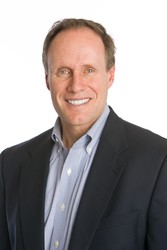
Stephen M.R. Covey is the author of Speed of Trust and his newest book, Trust and Inspire. He was the CEO of the Covey Leadership Institute that his father, who many of you may also be familiar with, Dr. Covey, created. Under Stephen’s leadership, the company grew to be the largest leadership development company in the world, operating in about 150 countries worldwide. These days, he shares his expertise on trust and leadership through keynote speaking opportunities.

